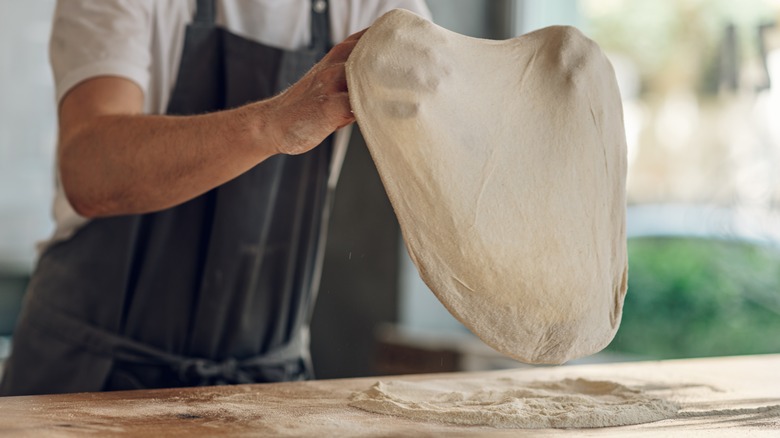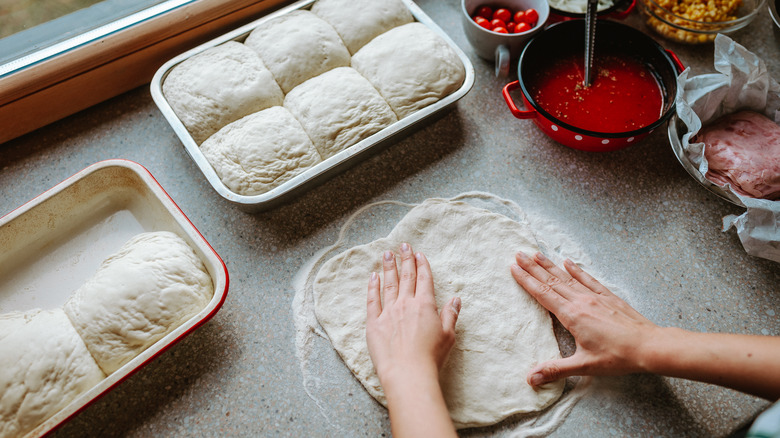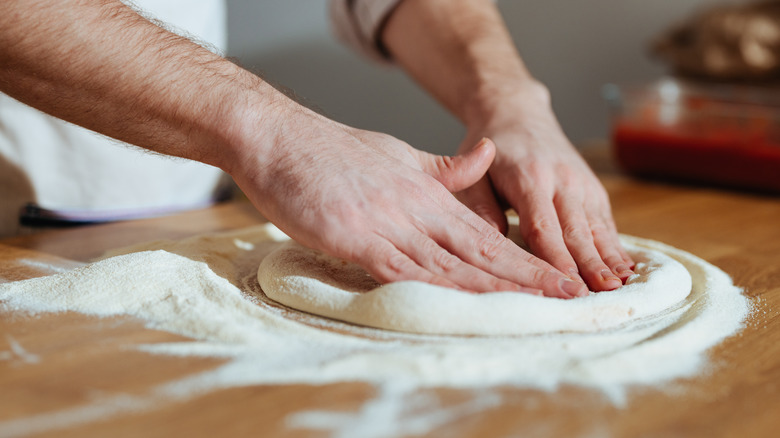The Temperature Secret To Correctly Stretch Pizza Dough
Homemade pizza is a wonderful thing, and there's something immensely satisfying about making the dough from scratch and stretching it by hand. But whether you're making your own or using store-bought options to create a DIY pie, it can be frustrating if the dough just won't behave in the way you're expecting. It may be due to one of a few factors.
For example, if it's tough to stretch, then chances are the dough is not at the right temp. Pizza dough needs to be at room temperature to stretch properly. So if you've just taken your store-bought dough out of the refrigerator, know that it needs to warm up a little. This could take anywhere from a half-hour to an hour or two, depending on how long it's been in the fridge, and how warm your kitchen is.
The reason cold dough won't stretch has to do with the gluten it contains. Gluten is what is responsible for giving a pizza crust its signature chewiness, but cold temperatures tighten those proteins. This tighter structure means that it's harder to stretch, as it can just shrink or spring back instead. Raising its temperature, however, gives back the elasticity it requires to be shaped.
Why room temperature is key for the best pizza dough
Gluten essentially forms when certain types of flour are mixed with water. The best flour for pizza is generally considered to be finely ground 00 flour, in part thanks to its ideal gluten and protein content, which make it elastic enough to knead properly while still retaining a light crust. In fact, choosing the wrong flour is one of the mistakes to avoid when making pizza dough so stick with the tried and true 00 option.
The process of kneading and resting the dough when making pizza enhances this elasticity, or stretchiness. And it's the way that the two proteins that make up gluten, glutenin and gliadin, react with each other that give it the perfect stretch, as well as allowing it to hold its shape when baked. Cold temperatures affect these proteins, so bringing dough to room temperature helps to loosen it again so it can be stretched without resistance.
If you're using dough from the refrigerator (even Giada De Laurentiis loves store-bought pizza dough since it saves so much time), here's how to warm it up. Remove it from the packaging, and place in a mixing bowl that you've lightly oiled (so it doesn't stick). Then, cover the bowl, and let the dough warm up before you start stretching it.
Pizza dough should always be stretched by hand
Watching a professional pizzaiolo chef effortlessly stretch and sling pizza dough as though it's the easiest thing in the world can look a little daunting. But if you're tempted to reach for the rolling pin to make the job easier at home, it can be a big mistake. And if you're making traditional Neapolitan style pizza, the use of a pin or mechanical press is actually forbidden according to the official Associazione Vera Pizza Napoletana rules. It's all about the hands, which make the best tool for stretching pizza dough.
A rolling pin can actually make the job more difficult, as it prevents the dough from stretching naturally, meaning it is more likely to spring back. Not only that, it's easier to tear fragile dough with a pin, and it also knocks out the air bubbles, which make the crust so deliciously light and chewy. And the last thing you want is a heavy texture that can fail to rise properly when baked.
Once your dough is stretched by hand, all you need to think about is what toppings to go for; whether you want to keep things simple and classic with a homemade bacon and mozzarella pizza, or even adorn your pie with the controversial pizza ingredient pineapple. Once you've got the perfect crust, it really is the perfect vehicle for whatever flavors you fancy.



